The Montgomery Palmetum
Text and photos by Katherine Maidman, former Palm Curator
At the center of the Garden’s palm collection is the Montgomery Palmetum, which begins just inside the main entrance.
While there are palms throughout the Garden, the Palmetum displays a large number of palms within a thirteen-acre area, grouping palms into plots mainly according to taxonomic relationships.
A meandering path through the Montgomery Palmetum takes you around these plots.
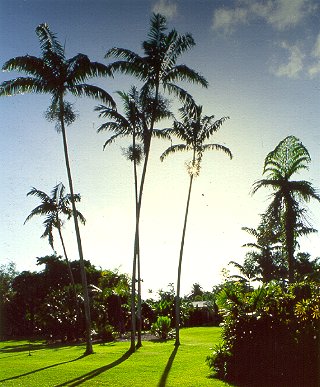 |
| Veitchia species in an informal grouping command attention in the Palmetum. This genus is distributed in the Philippines, New Hebrides, and Fiji. Veitchia species have been established in landscapes throughout the warm subtropics and tropics. They are fast growing palms and adaptable in cultivation. |
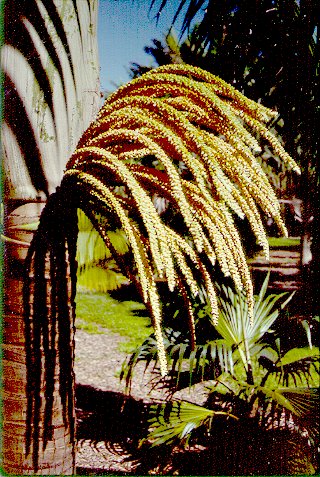 |
| Dictyosperma album This species comprises three varieties: var. album, var. aureum, and var. conjugatum. All are endemic to the Mascarene Islands and all are highly threatened in the wild. Major threats to the survival of this species are habitat loss on the islands and harvesting for palm heart. |
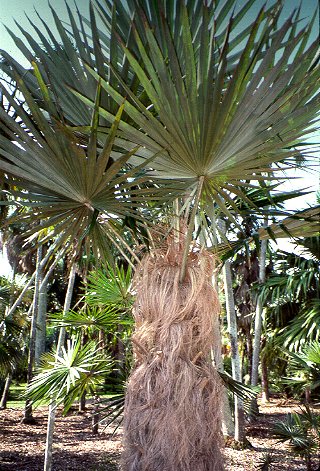 |
| Coccothrinax crinita ssp. crinita This Cuban species is known as the "old man palm" for the unusual leaf sheath fibers that cover the stem. It is one of many Caribbean species in the Palmetum. Although the Garden’s collection efforts are worldwide, there is a special emphasis on Caribbean Basin species. |
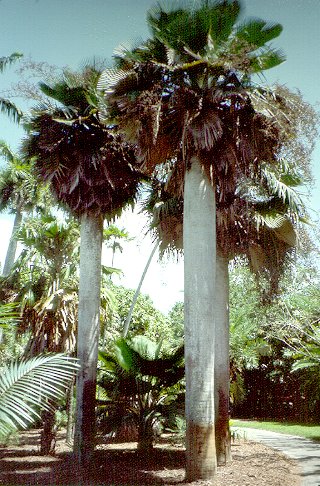 |
| Copernicia baileyana occurs in savannas and woodlands of Cuba. The Garden’s landscape architect, William Lyman Phillips, learned of this species when looking for salt tolerant palms for an area in the Garden’s lowlands. He made the most of this architechtonic palm by planting it in groups. |
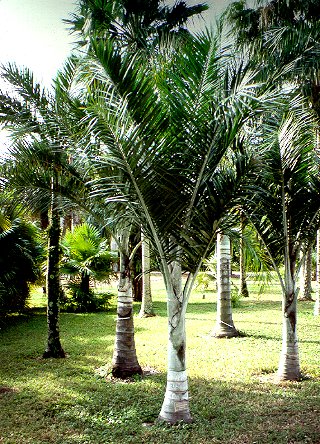 |
| Pseudophoenix sargentii ssp. sargentii Sargent’s cherry palm is a northern Caribbean species with a recent history that represents a case study in species conservation. Elliott Key is the site of the last remaining wild population of this subspecies in North America. Nearly lost in the Florida Keys from habitat destruction and poaching for use as landscape plants, the remaining wild population is now being preserved and replanted in a joint project with Biscayne National Park. Sargent’s cherry palm is a handsome and adaptable, but slow-growing ornamental palm. Pseudophoenix sargentii ssp. saonae, the one other subspecies, has a northern Caribbean distribution. |
 |
| Gastrococos crispa can be found in botanical gardens in many parts of the world but it is not commonly cultivated. Gastrococos is a monotypic genus (containing only one species) native to Cuba. Gastrococos crispa is a large, solitary palm of open savannas and calcareous soils with a trunk that develops a swollen midregion as the palm ages. The trunk also bears a distinctive covering of long spines, which are eventually shed. This palm produces long inflorescences with yellow flowers. The fruit are large and bright orange at maturity and are edible, often being used to feed livestock in its native country. The hollowed-out trunk of this palm has been used as a water trough or a canoe. |
 |
| Kerriodoxa elegans Native to just two localities in southern Thailand, Kerriodoxa elegans was discovered in 1929 and was described as recently as 1983. The large, undivided leaves have distinctive white undersides and brown-black petioles. This palm is still relatively uncommon in cultivation but is an adaptable palm for a shady situation. |
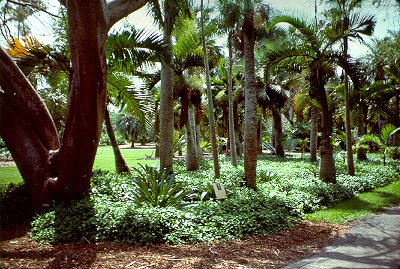 |
| Hyophorbe species There are five species in this genus from the Masacrene Islands and four are endangered in the wild. Specimens of three species are in one Palmetum plot. Hyophorbe species have a number of distinctive features, one of which is a large hornlike inflorescence bud. The bottle palm (H. lagenicaulis) and the spindle palm (H. verschefeltii) have these common names for their uniquely swollen trunks. |
© 1998-2004, Palm & Cycad Societies of Florida, Inc.
DHTML JavaScript Menu By Milonic.com
Copyright © 2007 Virtual Herbarium - All rights reserved
11935 Old Cutler Road, Coral Gables, FL 33156-4299 USA
Phone: 305-667-1651 • Fax 305-665-8032